Bluetooth Networking Project
Project Reflection:
I came into this week a complete novice about how networking works. Last week I got an RFID scanner to work, so I gained a little exposure to radio waves. I thought it would be cool to get Bluetooth working with this week's project. For this, I chose the Xiao ESP32C3 because of its Bluetooth capability and ability to connect to a phone. Initially, I had to download the NimBLEDevice library to be able to get it connected to my phone. Then, I got the BLE scanner in order to be able to connect to the microcontroller. I was initially confused by the app because there were so many different available connections, perhaps because I was in the SEC maker space, so it was hard to filter which I was looking for specifically. I then realized that there was a filter section so I could filter by the name that I set the microcontroller to present its connection as. After that, there was only one, which made it easier. I started by just establishing a connection and though it was pretty cool that this was able to happen. The code I used for this is below.
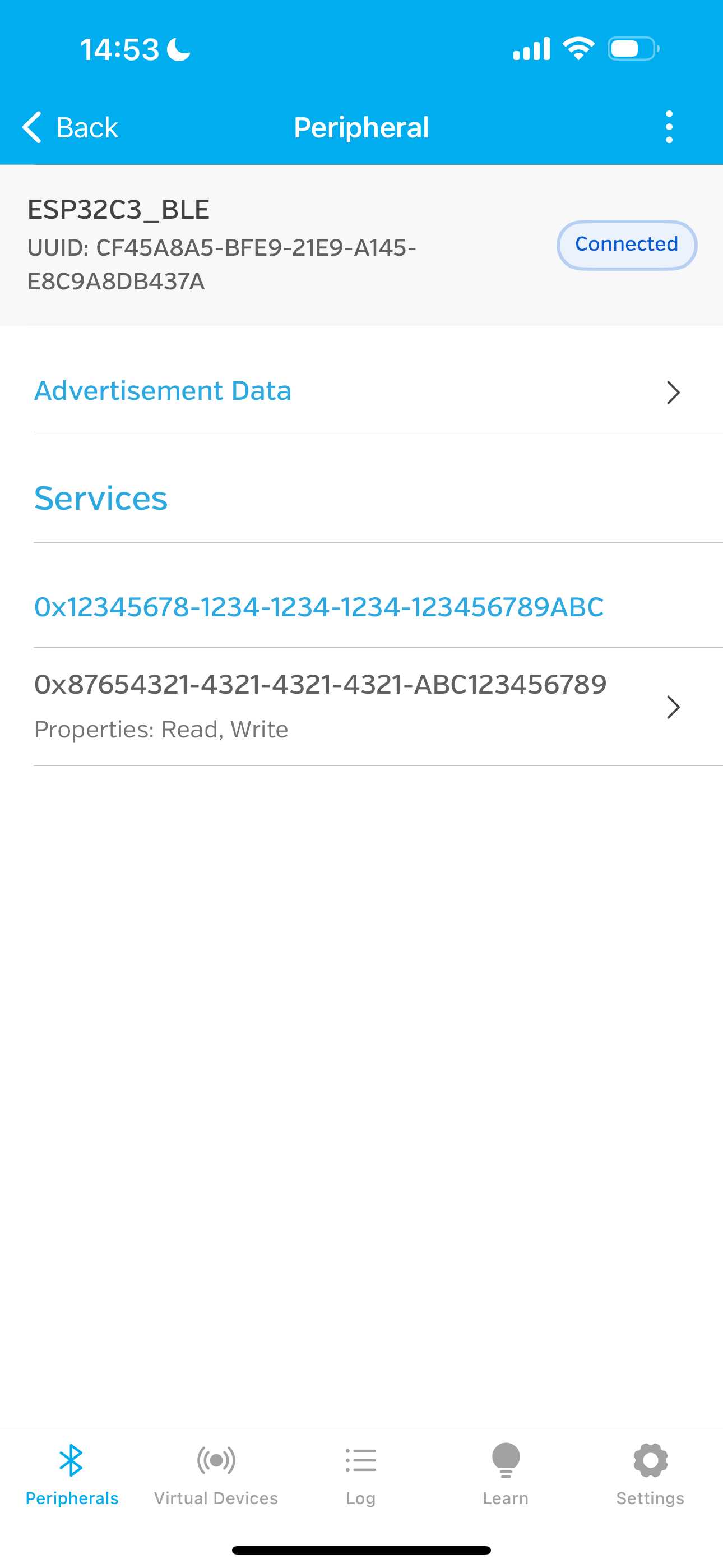
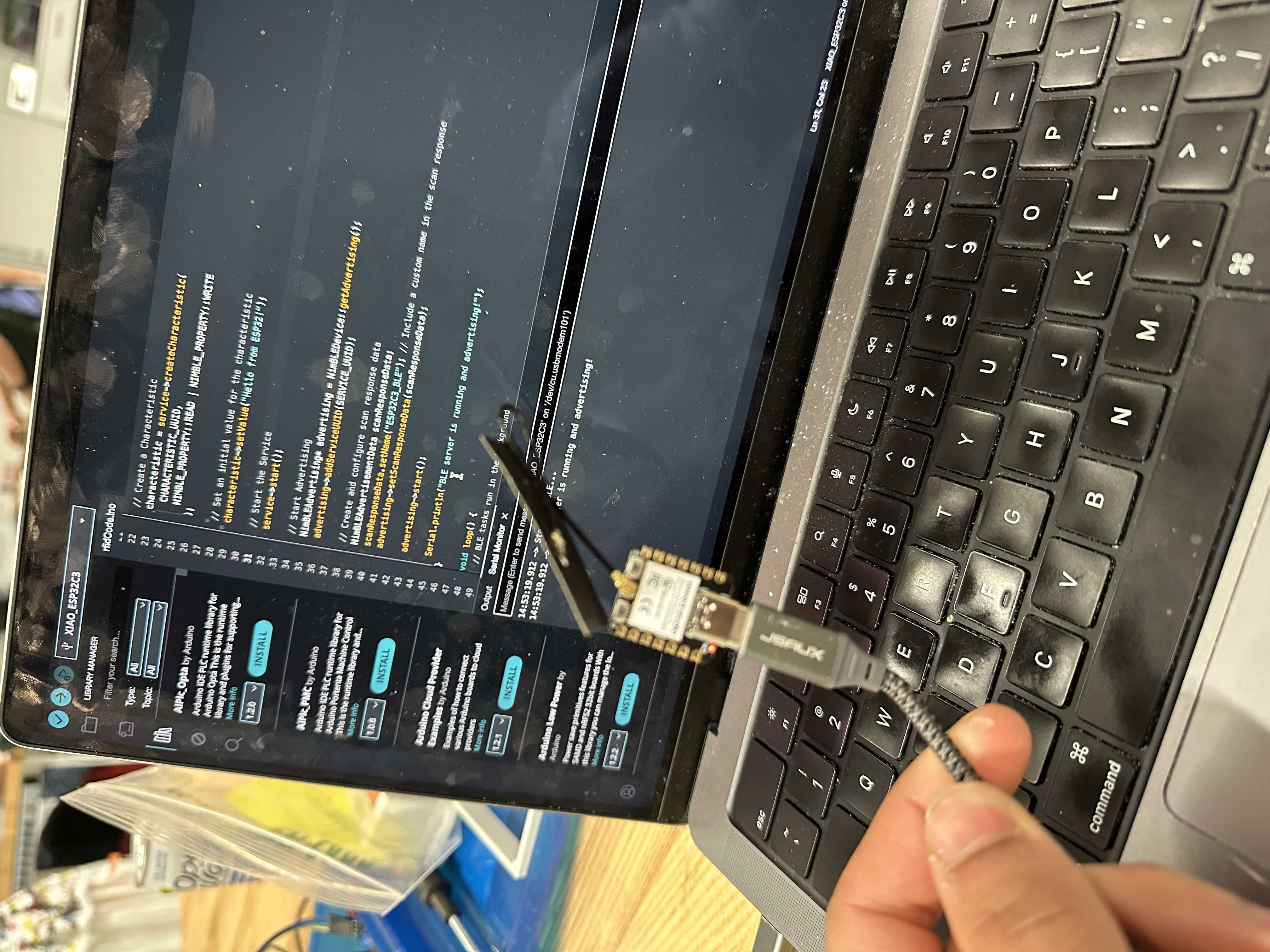
Establishing a Connection:
#include
// Define the BLE Service and Characteristic UUIDs
#define SERVICE_UUID "12345678-1234-1234-1234-123456789abc"
#define CHARACTERISTIC_UUID "87654321-4321-4321-4321-abc123456789"
NimBLECharacteristic* characteristic;
void setup() {
Serial.begin(115200);
Serial.println("Starting BLE...");
// Initialize BLE
NimBLEDevice::init("ESP32C3_BLE"); // Name of your BLE device
// Create a BLE Server
NimBLEServer* server = NimBLEDevice::createServer();
// Create a Service
NimBLEService* service = server->createService(SERVICE_UUID);
// Create a Characteristic
characteristic = service->createCharacteristic(
CHARACTERISTIC_UUID,
NIMBLE_PROPERTY::READ | NIMBLE_PROPERTY::WRITE
);
// Set an initial value for the characteristic
characteristic->setValue("Hello from ESP32!");
// Start the Service
service->start();
// Start Advertising
NimBLEAdvertising* advertising = NimBLEDevice::getAdvertising();
advertising->addServiceUUID(SERVICE_UUID);
// Create and configure scan response data
NimBLEAdvertisementData scanResponseData;
scanResponseData.setName("ESP32C3_BLE"); // Include a custom name in the scan response
advertising->setScanResponseData(scanResponseData);
advertising->start();
Serial.println("BLE server is running and advertising!");
}
void loop() {
// BLE tasks run in the background
}
Counter Functionality:
I saw that I was able to access a read and write function, so I knew that I would be able to send stuff from the Xiao to my phone. I first started with a counter that automatically started increasing after the connection was made to make sure I am able to read stuff. The code for this is below.
Counter Functionality:
#include
#include
#include
// Define the BLE Service and Characteristic UUIDs
#define SERVICE_UUID "12345678-1234-1234-1234-123456789abc"
#define CHARACTERISTIC_UUID "87654321-4321-4321-4321-abc123456789"
// Global Variables
BLECharacteristic* characteristic;
bool deviceConnected = false;
int counter = 0;
// Callback Class for Connection Events
class MyServerCallbacks : public BLEServerCallbacks {
void onConnect(BLEServer* server) override {
deviceConnected = true;
Serial.println("Device connected!");
}
void onDisconnect(BLEServer* server) override {
deviceConnected = false;
Serial.println("Device disconnected!");
// Restart advertising after disconnect
BLEAdvertising* advertising = BLEDevice::getAdvertising();
advertising->start();
Serial.println("Restarted advertising after disconnect.");
}
};
void setup() {
Serial.begin(115200);
Serial.println("Initializing BLE...");
// Initialize BLE
BLEDevice::init("ESP32C3_BLE");
// Create a BLE Server
BLEServer* server = BLEDevice::createServer();
server->setCallbacks(new MyServerCallbacks());
// Create a Service
BLEService* service = server->createService(SERVICE_UUID);
// Create a Characteristic with READ and NOTIFY properties
characteristic = service->createCharacteristic(
CHARACTERISTIC_UUID,
BLECharacteristic::PROPERTY_READ | BLECharacteristic::PROPERTY_NOTIFY
);
// Set an initial value for the characteristic
characteristic->setValue("Counter: 0");
// Start the Service
service->start();
// Start Advertising
BLEAdvertising* advertising = BLEDevice::getAdvertising();
advertising->addServiceUUID(SERVICE_UUID); // Advertise the service UUID
advertising->setScanResponse(true); // Include device name in scan response
advertising->start();
Serial.println("BLE server is up and advertising!");
}
void loop() {
// Update and notify counter value every 3 seconds if a device is connected
static unsigned long lastUpdateTime = 0;
unsigned long currentTime = millis();
if (deviceConnected && (currentTime - lastUpdateTime >= 3000)) {
lastUpdateTime = currentTime;
// Increment the counter and send the value as a notification
counter++;
String counterValue = "Counter: " + String(counter);
characteristic->setValue(counterValue.c_str());
characteristic->notify(); // Notify the connected device
Serial.println("Notified: " + counterValue);
}
}
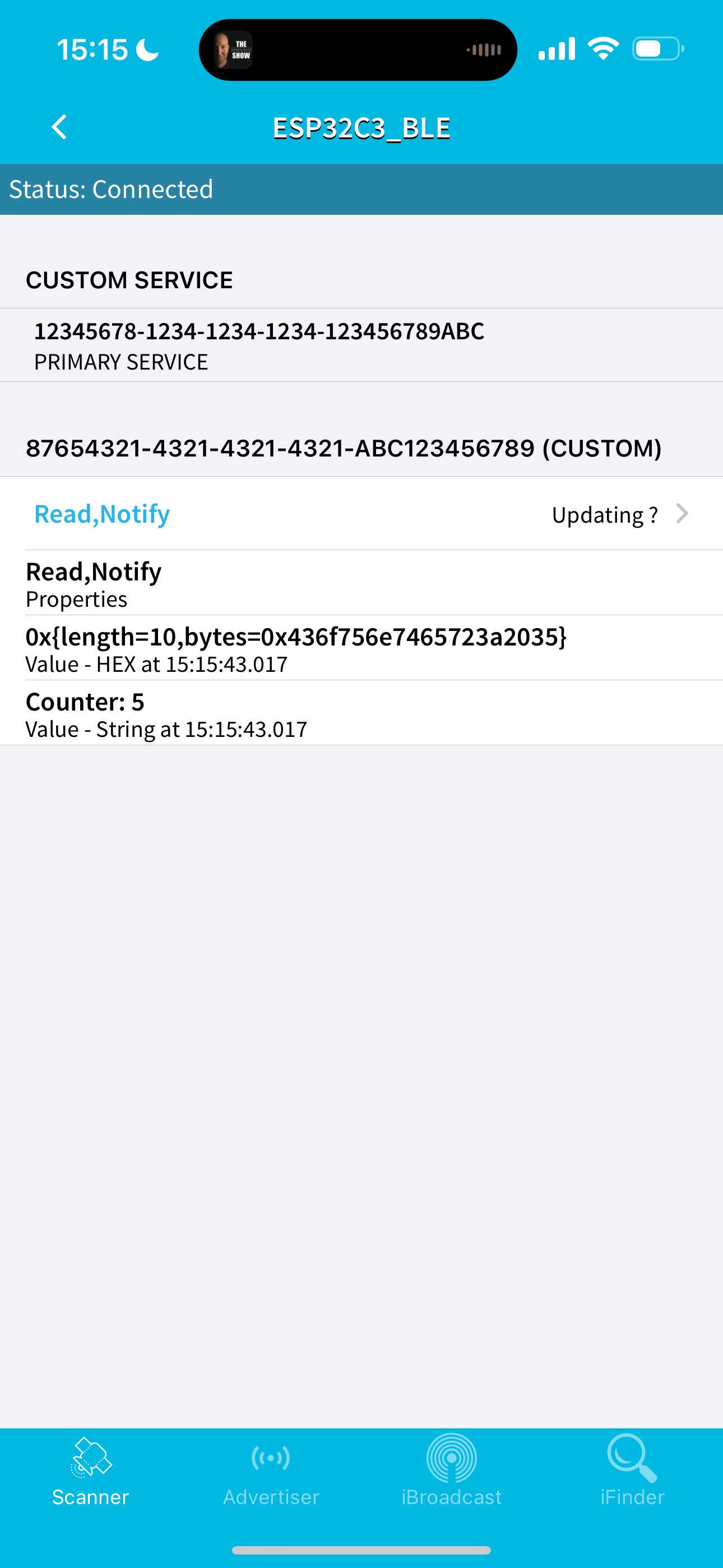
Adding a Button:
Next, I decided to add a button to have a local input and control the counter. Although I know to Neil’s dismay, I used a breadboard. I first wanted to make sure that the button connection would work on this Xiao because I have learned to always be hesitant about my soldering jobs and their ability to make the connection. I set up this button and used some simple code to use a counter function, and the button ended up working. However, it took a bit too long of having to change the wires since I placed the button down on the breadboard wrong. Probably just rust from Thanksgiving break. Lastly, I decided to combine the two functions to be able to see the counter on my phone. I ended up using a different library for the BLE when I sent signals, which consisted of just the BLE device, server, and Utils.
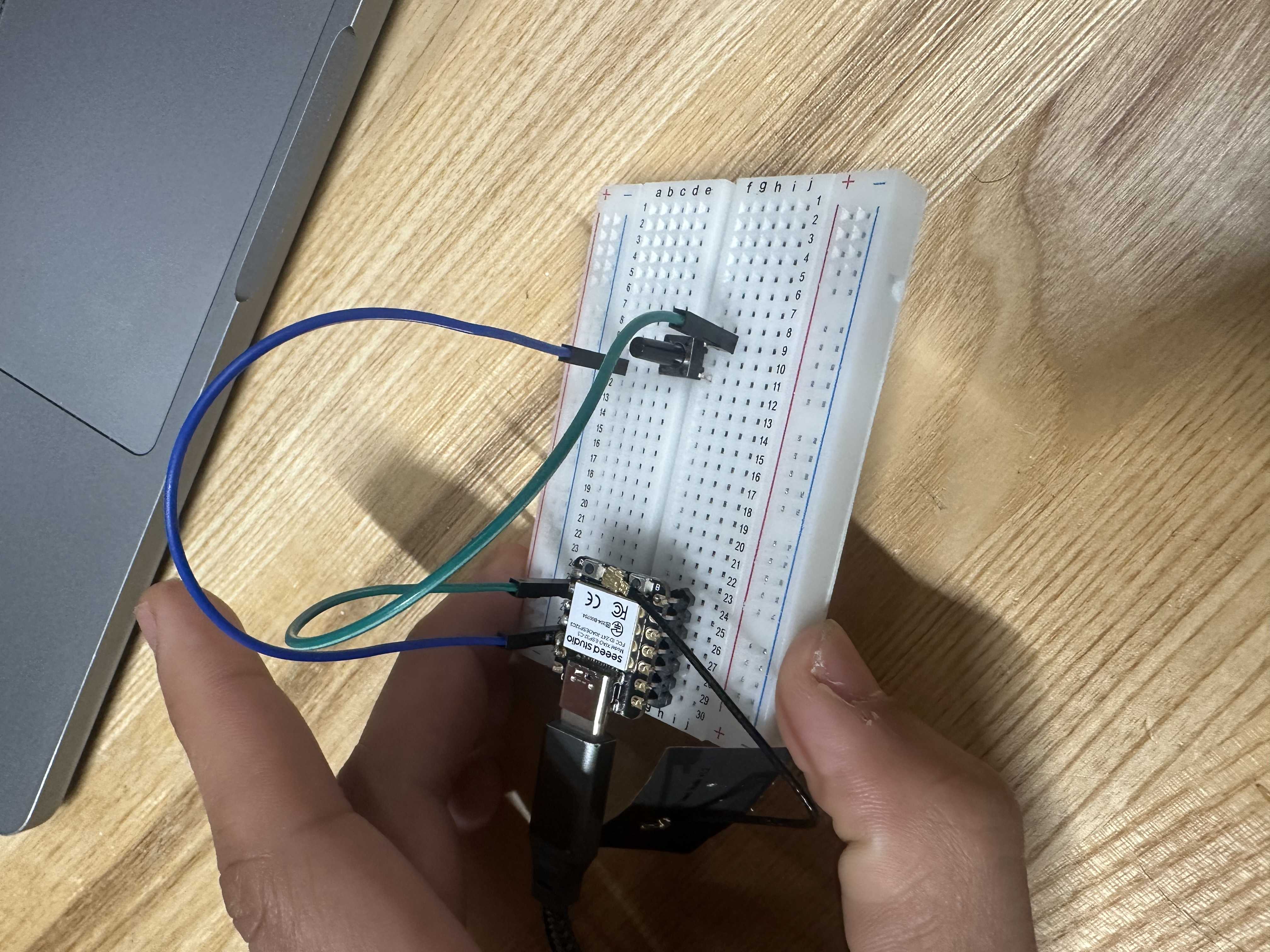
PCB Board Creation:
Lastly, I needed to make the PCB board. I know that it is late in the game and I will have to have a PCB making push, but thankfully Leo was able to help me use the SMR machine. I forgot how to use the original software I was shown, but then Leo showed me bitRunner, which is 100x better and now I am comfortable using it. Better now than never. My computer ended up glitching, and I had to run for dinner before I could finish the board with Leo, but I came back the next day to complete it. For whatever reason, the tape could not hold the board properly when I cut out the traces, so I had to manually break off the excess copper. I know this is jank and nasty, but I was not sure what else to do. And finally, I had the final product for this week, and it worked!
My Images and code for this are shown below:
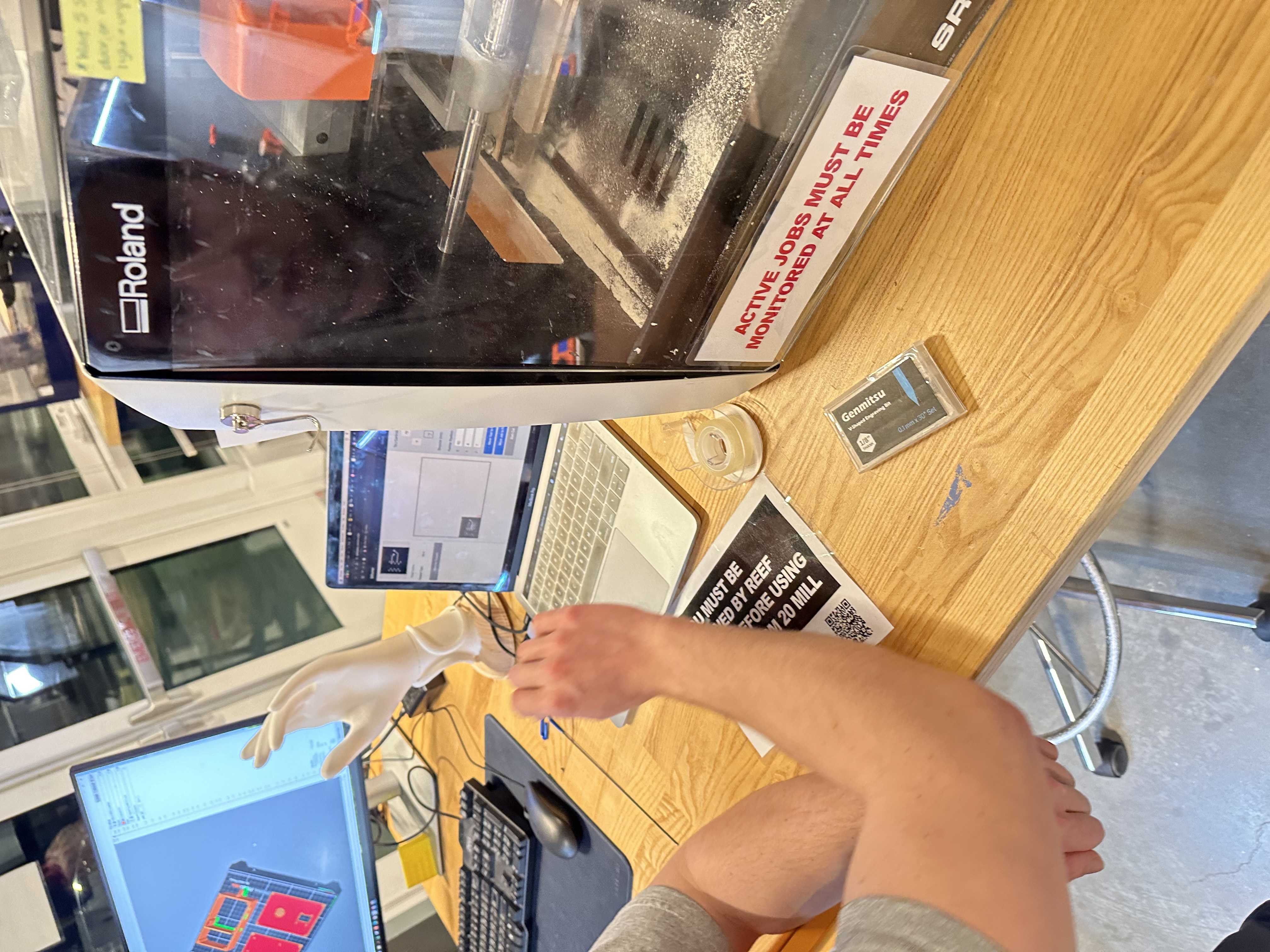
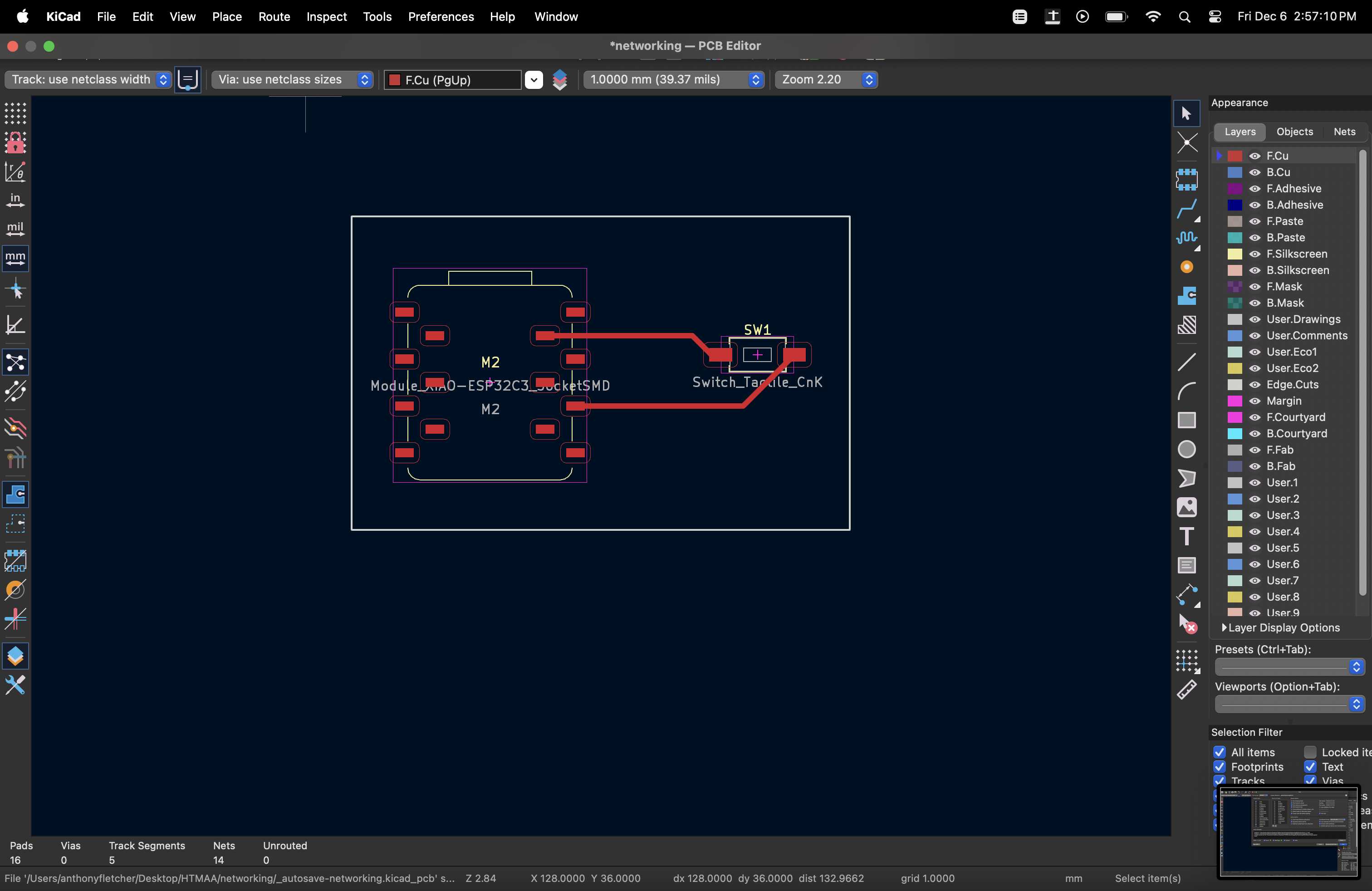
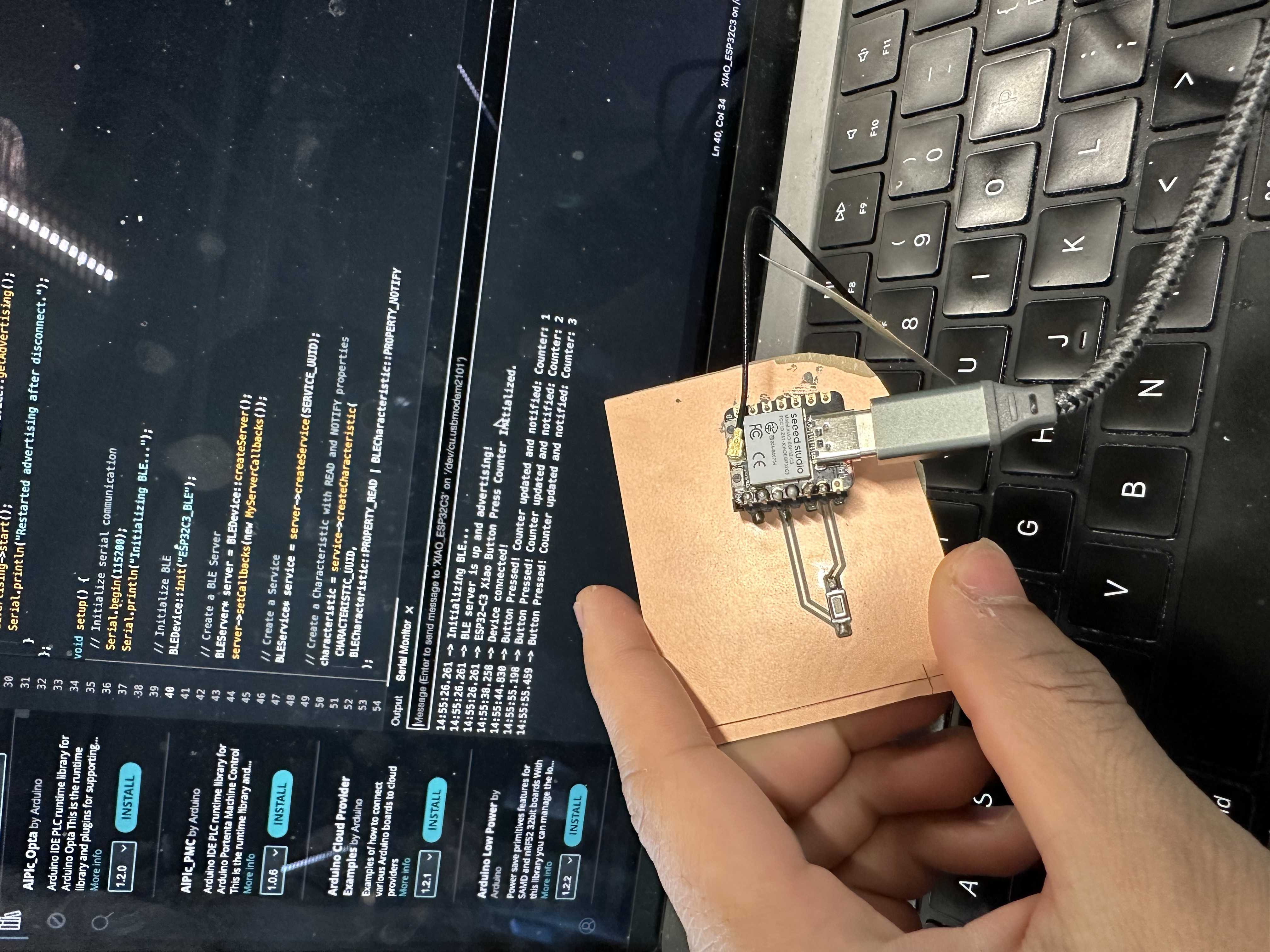
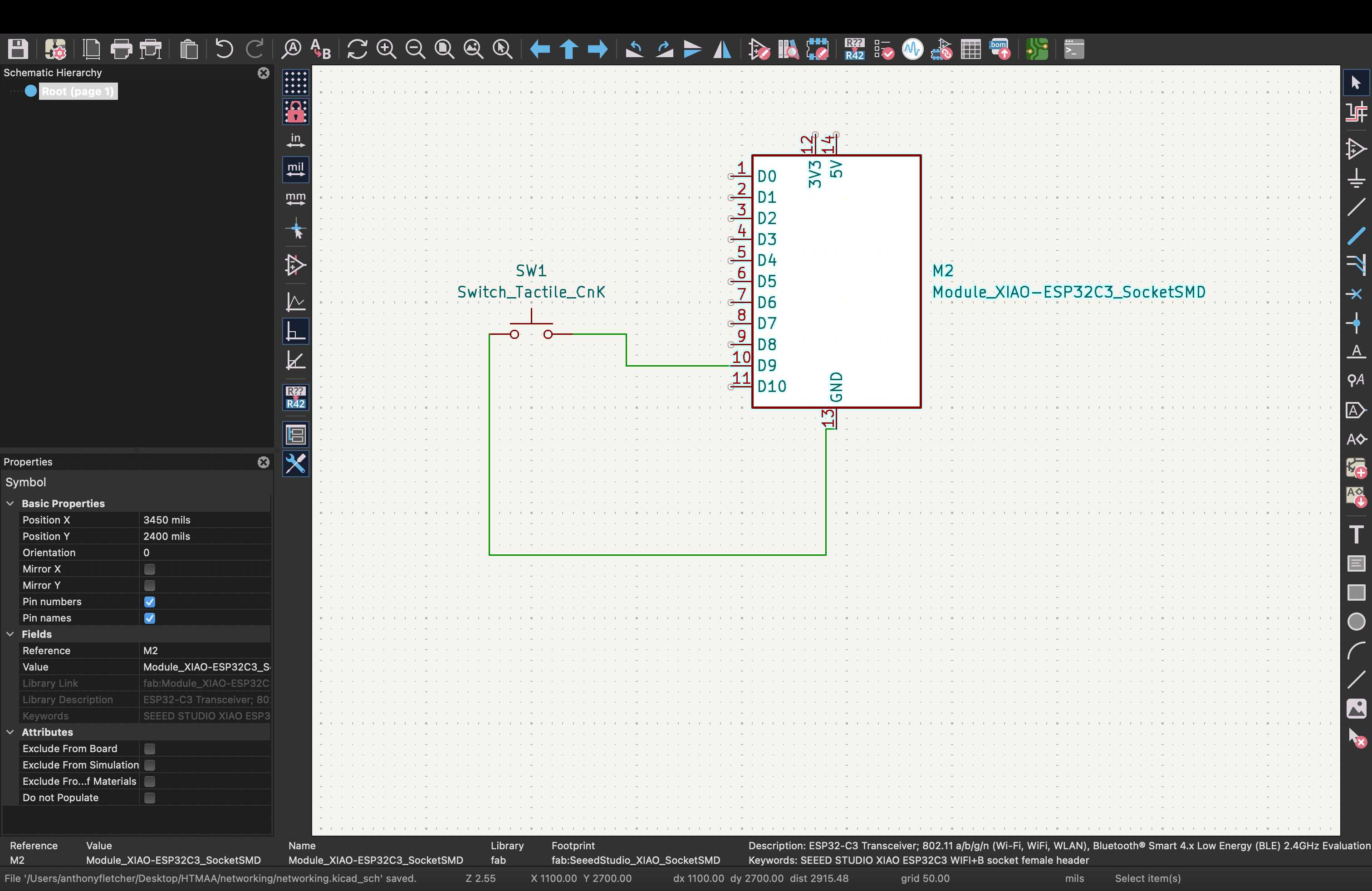
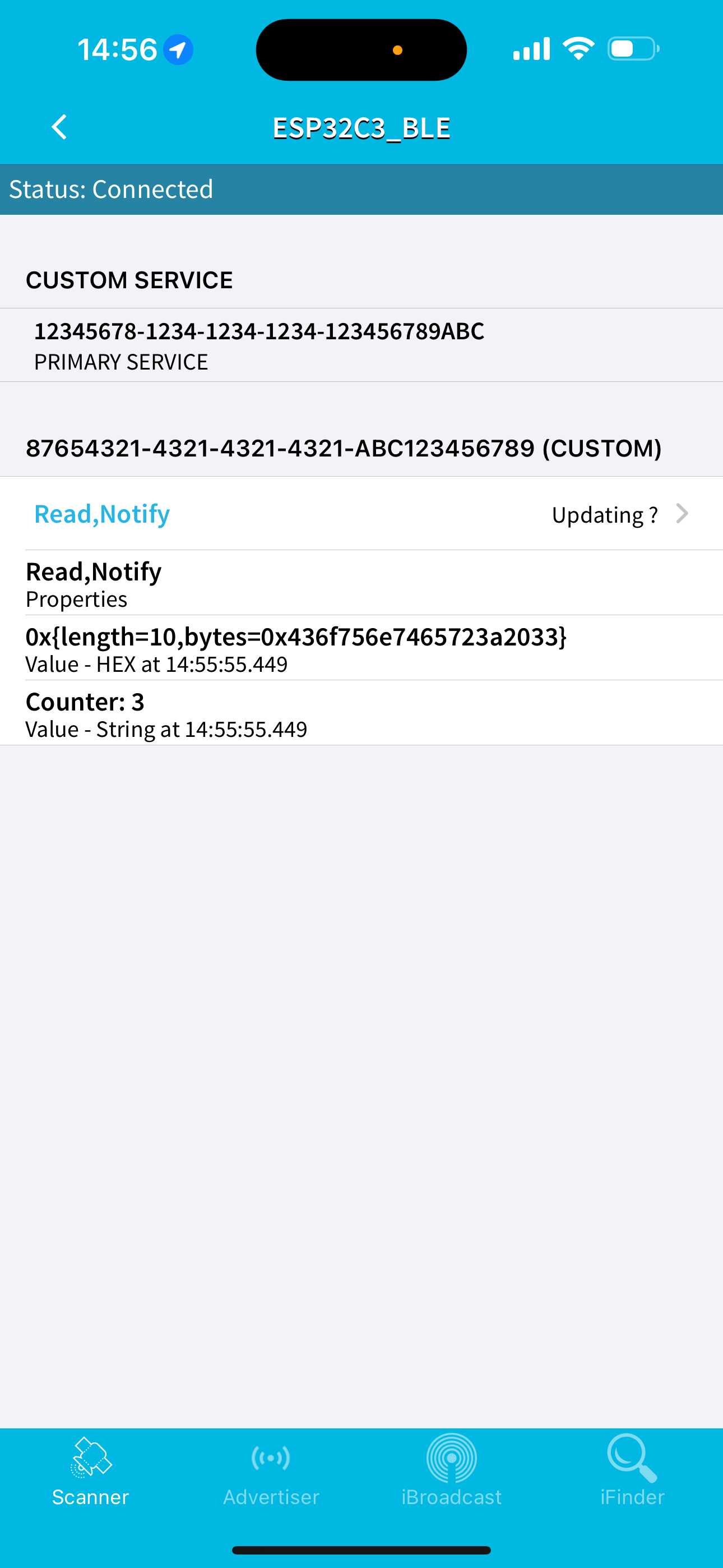
Final Code:
#include
#include
#include
// Define the BLE Service and Characteristic UUIDs
#define SERVICE_UUID "12345678-1234-1234-1234-123456789abc"
#define CHARACTERISTIC_UUID "87654321-4321-4321-4321-abc123456789"
// Define GPIO pins
#define BUTTON_PIN 9 // Pin connected to the button
// Global Variables
BLECharacteristic* characteristic;
bool deviceConnected = false;
int counter = 0;
// Callback Class for Connection Events
class MyServerCallbacks : public BLEServerCallbacks {
void onConnect(BLEServer* server) override {
deviceConnected = true;
Serial.println("Device connected!");
}
void onDisconnect(BLEServer* server) override {
deviceConnected = false;
Serial.println("Device disconnected!");
// Restart advertising after disconnect
BLEAdvertising* advertising = BLEDevice::getAdvertising();
advertising->start();
Serial.println("Restarted advertising after disconnect.");
}
};
void setup() {
// Initialize serial communication
Serial.begin(115200);
Serial.println("Initializing BLE...");
// Initialize BLE
BLEDevice::init("ESP32C3_BLE");
// Create a BLE Server
BLEServer* server = BLEDevice::createServer();
server->setCallbacks(new MyServerCallbacks());
// Create a Service
BLEService* service = server->createService(SERVICE_UUID);
// Create a Characteristic with READ and NOTIFY properties
characteristic = service->createCharacteristic(
CHARACTERISTIC_UUID,
BLECharacteristic::PROPERTY_READ | BLECharacteristic::PROPERTY_NOTIFY
);
// Set an initial value for the characteristic
characteristic->setValue("Counter: 0");
// Start the Service
service->start();
// Start Advertising
BLEAdvertising* advertising = BLEDevice::getAdvertising();
advertising->addServiceUUID(SERVICE_UUID); // Advertise the service UUID
advertising->setScanResponse(true); // Include device name in scan response
advertising->start();
Serial.println("BLE server is up and advertising!");
// Configure the button pin as input with an internal pull-up resistor
pinMode(BUTTON_PIN, INPUT_PULLUP);
// Print startup message
Serial.println("ESP32-C3 Xiao Button Press Counter Initialized.");
}
void loop() {
// Read the state of the button
int buttonState = digitalRead(BUTTON_PIN);
// Check if the button is pressed
if (buttonState == LOW) {
// Increment the counter
counter++;
// Update the BLE characteristic and notify the connected device
if (deviceConnected) {
String counterValue = "Counter: " + String(counter);
characteristic->setValue(counterValue.c_str());
characteristic->notify();
Serial.println("Button Pressed! Counter updated and notified: " + counterValue);
} else {
Serial.println("Button Pressed! Counter updated: " + String(counter));
}
// Debounce delay
delay(200);
}
// Small delay to improve loop stability
delay(50);
}